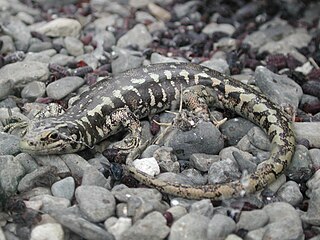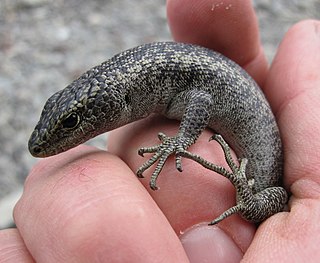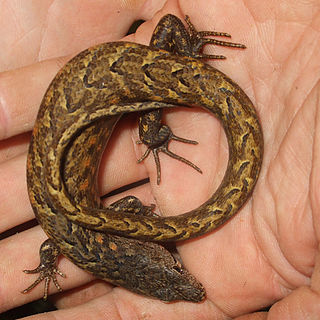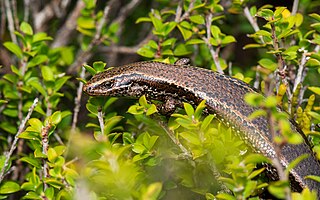
Oligosoma is a genus of small to medium-sized skinks found only in New Zealand as well as Norfolk and Lord Howe islands. Oligosoma had previously been found to belong to the Eugongylus group of genera in the subfamily Lygosominae; the Australian genus Bassiana appears to be fairly closely related.
The long-toed skink is a species of skink of the family Scincidae, endemic to New Zealand. It was first described by Geoff Patterson in 1997. It is only known from a few sites in the South Island of New Zealand and little is known of its habits. It seems to prefer dry, rocky habitats, usually eroding stream terraces or scree slopes. It is diurnal and heliothermic. Maximum snout-vent length is about 70 mm.

The Scree skink is a species of skink native to several sites throughout the South Island of New Zealand. A member of the family Scincidae, it was described by Geoff Patterson in 1997. It favours rocky habitats, particularly greywacke screes. Threats to scree skinks include predation by introduced mammals, weed encroachment, human interference and severe flood events.

The robust skink, Oligosoma alani, is a large, rare species of lizard in the family Scincidae. The species is endemic to New Zealand.

Whitaker's skink, also known commonly as Whitaker's New Zealand skink, is an endangered species of skink, a lizard in the family Scincidae. The species is found only in New Zealand.

The chevron skink, is a large species of skink endemic to New Zealand, found only on Great and Little Barrier islands in the Hauraki Gulf. A cryptic forest dweller, it can hide underwater, and is under threat from introduced rats.
The small-scaled skink is a species of skink in the family Scincidae. It is endemic to New Zealand. The holotype is in the collection of the Museum of New Zealand Te Papa Tongarewa.

The southern skink is a species of skink in the family Scincidae. It is endemic to New Zealand.
Oligosoma taumakae, the Open Bay Island(s) skink, or Taumaka skink, is a species of skink. It was described from the Open Bay Islands, off the west coast of the South Island of New Zealand.
The slight skink is a skink of the family Scincidae, endemic to the far north of the North Island of New Zealand. The precise distribution is unknown; currently it is only known from localities in the Te Paki region of Northland. It closely resembles the copper skink, Oligosoma aeneum, and was considered to be a member of this species until recently when it was described as a new species using morphological, allozyme and DNA methods. O. levidensum is difficult to distinguish morphologically from O. aeneum, which is probably why it had not been recognised until recently. The main distinguishing feature is the slighter overall body form of O. levidensum compared to O. aeneum. The limbs of O. levidensum are reduced compared to O. aeneum and O. hardyi, the other members of the O. aeneum complex.
The ornate skink, Oligosoma ornata, is a rare species of skink endemic to New Zealand. This species was once widespread through much of the North Island and on many offshore islands in the Hauraki Gulf and north of the Coromandel Peninsula. Habitat destruction and predation by introduced species has now reduced their range to scattered localities throughout the North Island as far south as Wellington, as well as on the Three Kings Islands, Great Barrier Island, and a few other offshore islands.
The Barrier skink is a species of medium-sized skink, a lizard in the family Scincidae. The species is endemic to New Zealand, where it lives in the alpine habitat of the Darran and Takitimu Mountains of Fiordland. It is one of only two species of New Zealand skinks that live exclusively in the alpine zone, the other being the "Sinbad skink", Oligosoma pikitanga, a closely related species of similar appearance which is found in the same part of the South Island. The Barrier skink was first collected in the 1960s but was overlooked until rediscovery by a pair of mountain climbers in 2005; the species was scientifically described in 2009.

The Te Kakahu skink is a critically endangered species of skink native to New Zealand. When discovered, the entire species was inhabiting a single patch of clifftop vegetation on Chalky Island in Fiordland National Park.

The Burgan skink is a nationally endangered species of skink native to New Zealand. It was described from a specimen found near the Burgan Stream, in the Rock and Pillar Range, Central Otago.

The cryptic skink is a nationally vulnerable species of skink native to New Zealand.

The spotted skink is a nationally at risk species of skink native to New Zealand. The Spotted skink is currently known to be present in the Hawkes Bay, Wairarapa and Wellington regions as well as in Nelson, Marlborough and Canterbury. It is also present on Somes Island, Mākaro / Ward Island, North Brother Island and Stephens Island. Adult males and adult females of the species significantly differ in the snout-vent length with body sizes reaching 111mm. Females produce around 3 - 4 young.

The brown skink is a species of skink native to New Zealand.
The cobble skink in the family Scincidae is a skink species endemic to New Zealand, found only on a single small stretch of stony beach at Granity, on the West Coast. In 2016 it was on the brink of extinction, with declining numbers and a threatened habitat, and all known individuals were captured and taken to Auckland Zoo.

The Alborn skink is a critically endangered and poorly known species of skink only found in a single 2 ha site near Reefton, New Zealand. It is classified as "Nationally Critical" by the Department of Conservation under the New Zealand Threat Classification System.

The Chesterfield or Kapitia skink is a species of skink found in New Zealand. Only discovered in 1994 and for years not recognised as a distinct species, it is endemic to a narrow 1 km strip of coastal vegetation on the West Coast of New Zealand, 15 km north of Hokitika. There are fewer than 200 individuals remaining in the wild. Oligosoma salmo is the only New Zealand skink with a prehensile tail, suggesting it was once arboreal and inhabited coastal forest, which was subsequently cleared for dairy farming. Following the partial destruction of its remaining habitat in 2018 by a cyclone, a small captive breeding population was established at Auckland Zoo.















